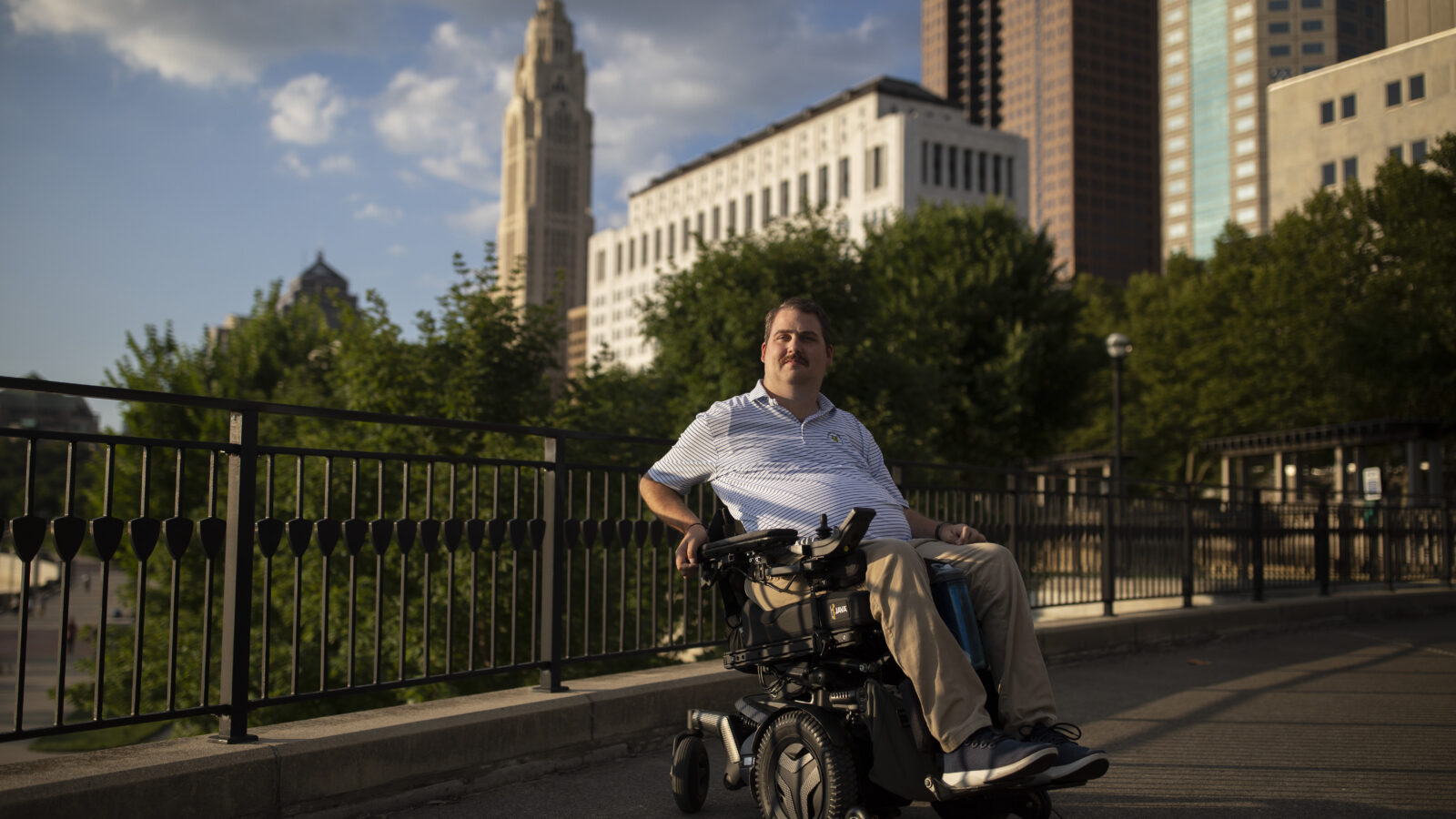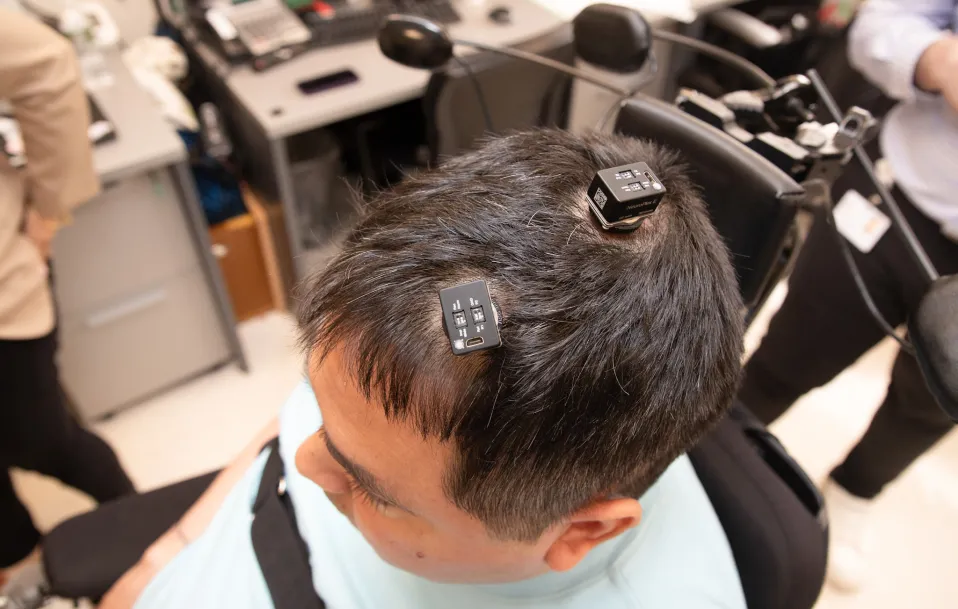By Elissa Welle
Three years after he was paralyzed from the chest down, Ian Burkhart faced a dilemma. He received a phone call from the Ohio State University asking him, as one of the few patients with a spinal cord injury living near Columbus, Ohio, to join a brain-computer interface (BCI) study.
The problem was, no one could answer his most pressing questions.
Surgeons reassured him of the procedure’s safety. Researchers talked him through the experiments using his brain to direct electrical pulses into the viable but disconnected muscles in his arm to move them again.
But what Burkhart wanted was a peer mentor. How would he shower or sleep with the port sticking out from his skull? What would it be like trekking to and from the laboratory several days a week for the next few months, or years? And would he feel the device in his brain?
Ultimately, he took the risk to join the clinical trial in 2014, becoming somewhere between the 12th and 15th person in the world with a BCI.
Now, Burkhart is creating a group for the BCI community led by its pioneering users to discuss the kinds of questions he had seven years ago — and to serve more broadly as a forum to talk with others in the BCI community. The BCI Pioneers Coalition will center on the unique experience of Burkhart and his peers, whose numbers have nearly doubled since Burkhart received his BCI.
“Now it’s up to the mid-30s, and it’s still a very unique experience,” Burkhart said. “Being able to share that is only going to help people learn.”
The BCI field is reaching an inflection point as the research-only technology is being advanced by commercial interests. With the expected influx of patients — and money — Burkhart intends to lead the discussions into difficult, but necessary, territory in quarterly webinars, beginning in September.
Who owns data extracted from someone’s brain? What is autonomy when some version of your thoughts are read into a circuit board? Is the goal restoration of movement, augmentation, or maybe enhancement? In what ways are patients allowed to use their BCI?
“A lot of these questions aren’t black and white,” Burkhart said. “They live in the gray area and they’re so nuanced that you have to have a bunch of different perspectives in order to really get anywhere that’s substantial.”
The BCI Pioneers Coalition is not a traditional patient support group — Burkhart is already the vice president of the North American Spinal Cord Injury Consortium and president of a foundation that financially supports patients. Rather, it’s a grassroots effort by BCI users to center the discussion on patient experiences, led by the patients.
That doesn’t mean others aren’t welcome. The coalition will invite neural technologists, BCI company CEOs, clinicians, ethicists, the BCI-curious public, and investors to a virtual gathering space with chat and video channels. There will be group-specific channels to hash out questions relevant to the group, and a main gathering space for all to voice and listen to opinions.
Jan Scheuermann, a BCI user and a founding member of the group, said part of the goal is to get different kinds of people touched by the technology in one place.
By bringing together the engineers and researchers with “the people who have been on the other side, the lab rats,” as Scheuermann calls herself, “hopefully all these people brainstorming together might come up with some new ideas or perspectives.”
Burkhart said he hoped the gathering of BCI patients with the people on the other end of the computer will attract young minds to the research labs and commercial companies developing BCIs, and encourage the original researchers to keep at it after decades of trials and errors.
“They’re not just working on a chip of silicon, they’re working on something that can really impact someone’s life,” Burkhart said. “I had people come up and say, ‘I’ve been working on this type of research for years and I’ve never met a human who actually used one.’”
There are roughly 54 million people in the U.S. living with some form of paralysis, making BCIs a distant reality for all but a select few. For years, Burkhart delivered devastating reality checks to paralyzed patients who saw video clips of him playing Guitar Hero. “I had to tell them … ‘Just wait, it’s only a few years away.’ That’s really challenging because that’s what our community has been told for decades.”
Now, with BCI companies hoping to expand the market for the technology, a new wave of users is expected to feel the complex bundle of emotions — fear, uncertainty, joy, excitement, relief and sadness — experienced by the field’s pioneers. The hope is that Burkhart’s coalition can be there to help them along the process.
“There’s no substitute for that,” Burkhart said, reflecting on the peer mentor he never had.
Burkhart and Scheuermann founded the group with two other BCI users; each has made a bit of idiosyncratic medical history. Scheuermann made news when she fed herself a chocolate bar using her BCI, which she named Hector. Burkhart was the first to use his brain to reanimate his own paralyzed arm using muscular electrical stimulation.
Current BCI users Nathan Copeland and Nancy Smith are still making firsts. Copeland was the first to feel sensation in his hand through electrical stimulation delivered directly to his brain. He was also the first to fistbump a U.S. president. Smith was the first to play a virtual piano, using her subconscious, no less.
The experiences of the coalition founders reflect the diversity of any patient group. While Burkhart had dozens of questions before his surgery, Copeland had none. “There are things now I don’t think I could have even thought to ask at the time,” he said.
While Copeland dabbles in the unique benefits of BCIs, like using a take-home BCI system to create digital art, he said he wants to maintain the industry’s focus on what potential BCI users might want, which might not necessarily be the flashiest tech.
Burkhart agrees. “These are devices that are going inside humans,” he said. “We can make sure that these devices are going in the right direction, where they’re going to be something that can get to market and be successful so more and more people can have access and benefit from them.”
The Food and Drug Administration does not require companies designing clinical trials to incorporate patient advice. Instead, FDA guidelines “highlight the benefits of engaging with patient advisors early in the medical device development process.”
If a group of BCI participants already exists, companies may be inclined to incorporate their perspectives and values into a clinical trial, said Kate Gelman of Precision Neuroscience and formerly of Neuralink, two new BCI companies.
Burkhart, she said, “would give a voice to those patients on an even playing field as the people with all the money, who tend to get an outsized voice.”
Now that Burkhart’s brain is metal-free — his BCI was explanted from his brain in August last year, once the final clinical trial he participated in was complete — he views the new coalition as a way to stay plugged into the unique world of BCIs that has been his home for years. “I’ve seen the promise and the potential of these types of devices,” Burkhart said.
He and his fellow BCI pioneers are the experts now, and they’re here to be heard.


